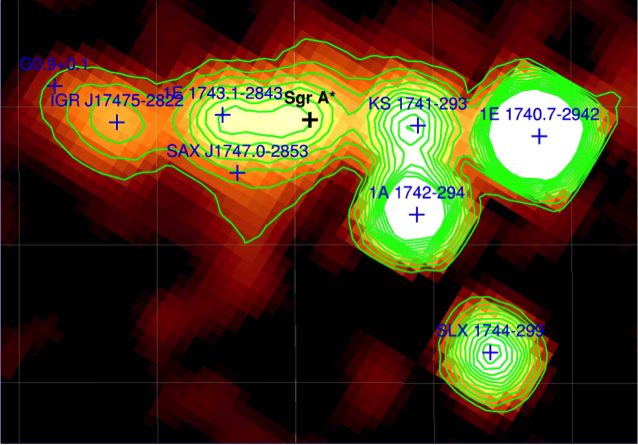The Galactic Center in the MeV range
The Galactic Centre harbours the closest supermassive black hole to Earth and is therefore a fundamental laboratory to understand the physics of these objects and their interaction with their environment. An emission coincident with the Galactic Centre position is observed all over the high-energy domain and understanding its origin is crucial. Because of the extreme density of potential high-energy emitters in the region a good angular resolution is mandatory.
The Galactic Centre region is also the site of intense star formation and particle acceleration. There is now good evidence that the central 200 pc are pervaded by low-energy cosmic rays thanks to H3+ measurements. The measurement of the sub GeV cosmic-ray content can then be performed thanks to possible nuclear excitation lines and by separating the hadronic and leptonic contributions with spectral measurements in the range of tens of MeV. For the latter point, in the absence of clear spectral signatures, a good angular resolution is important to really separate diffuse processes from individual objects.
Required instrument performances:
The Galactic Centre region is also the site of intense star formation and particle acceleration. There is now good evidence that the central 200 pc are pervaded by low-energy cosmic rays thanks to H3+ measurements. The measurement of the sub GeV cosmic-ray content can then be performed thanks to possible nuclear excitation lines and by separating the hadronic and leptonic contributions with spectral measurements in the range of tens of MeV. For the latter point, in the absence of clear spectral signatures, a good angular resolution is important to really separate diffuse processes from individual objects.
 The Galactic Centre as observed with IBIS/ISGRI on board INTEGRAL. The angular scale of this image is about 2.5° x 1.5°. Credit: G. Bélanger (CEA Saclay) et al. |
Required instrument performances:
| Performance parameter | Goal value | Remarks and notes |
|
Field-of-view (FWHM, deg) |
Not really constraining since the region of interest is 2° in diameter | |
|
Angular resolution (FWHM, deg) |
< 0.2° | For 4.4 and 6.2 MeV line, the emission will be detected with angular size beyond the degree so that this constraint can be alleviated for this specific topic |
|
Spectral resolution (ΔE/E @ Energy) |
3 – 5% @ 4.4 MeV | |
|
Line sensitivity (@ Energy) (cm-2 s-1, 3σ, 1 Ms) |
< 10-5 @ 4.4 and 6.2 MeV | Note: over > 1 deg. |
|
Continuum sensitivity (in which energy band?) (cm-2 s-1 keV-1, ΔE=E, 3σ, 1 Ms) |
< 5×10-12 erg/cm2/s over the whole range |
Sensitivity for possible Sgr A* flares would be quite high since they last ~ 1 h and their peak flux is about 10-11 erg/cm2/s. The sensitivity is given in energy flux since it is a general constraint on the energy range |
| Timing performances | No constrains | |
|
Polarimetric capability (Minimum Polarization Fraction for a Crab source in 1 Ms) |
|
|
| Real-time data? |
 AstroMeV
AstroMeV